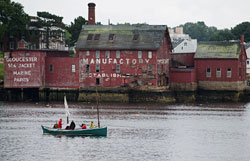America's First Copper Paint
 The Tarr and Wonson Copper Paint Factory
The Tarr and Wonson Copper Paint Factory Photo by Iain Kerr
For centuries, ship captains have sought ways to prevent the growth of barnacles, grasses, and other marine life forms from growing on the bottoms of their vessels. Heavy infestation, called fouling, can cause considerable drag, slowing ships and hindering maneuverability. Some marine pests can even bore into the ship's wooden hull and threaten the safety of the crew.
Augustus H. Wonson and his son Gardiner found a remedy by creating copper, anti-fouling paint for boat bottoms. Partnering with James G. Tarr, the Tarr and Wonson Paint Factory began manufacturing the first copper, bottom paint in 1863 in Gloucester, Massachusetts. It was a mix of tar, dry copper oxide, and naphtha or benzine, blended in a time-consuming three-step process. The original patent proclaims, "We have found by experiment that the hull of a vessel painted with our composition has remained free from shells and weeds for a period of twelve months, while another vessel painted in the common manner and employed in the same trade became so foul in six weeks as to require scraping."
The paint was so successful, the Tarr and Wonson Paint Factory made copper paint for the maritime industry for over a hundred years, sending this paint to ship owners all over the world. When the factory closed in 1980, it remained vacant for almost 30 years until Ocean Alliance, an oceanographic research organization, bought it to house its headquarters.
"I really believe the invention of Tarr and Wonson's copper paint launched the first industrial revolution in North America, which was commercial fishing," said Iain Kerr, Vice President and CEO of Ocean Alliance. "You cannot underestimate the effect it had on American society. Not only did it help in fishing, but it helped in commerce, it helped in warfare, and it helped in recreation."
Kerr, who also is a ship captain and piloted Ocean Alliance's research vessel Odyssey, knows the value of this paint. "In the old days in warfare, it would take days just for the boats to get close and then they would start shooting. If you saw a boat on the horizon and your bottom was not foul, it didn't matter if they had more sail or not. You could just sail away," he said. Prior to copper, anti-fouling paint, navies would sheath the bottoms of boats with layers of thin, copper sheeting. "Think how expensive or heavy that was," Kerr adds.
Copper paint proved essential for the commercial fisherman.
"If you put a coat of paint on the bottom of a hull and not have to scrape it for a year, instead of every six weeks, suddenly you've got a business," Kerr explained. "And, with a clean bottom, these boats might be sailing anywhere between six and twelve knots. With a dirty bottom, they might be going three knots or two knots." This allowed fishermen to get to their fishing grounds quicker and get back to shore faster. Even when motors were added, having a dirty bottom could increase a businesses expenses further. "You might be doubling or tripling your fuel consumption."
Today, Ocean Alliance will pay tribute to the legacy of the Tarr and Wonson Paint Factory as it refits the factory buildings into its new headquarters. Based in Lincoln, Massachusetts, Kerr jokingly said, "We've been lost in the woods of Lincoln for about 39 years! We should be on the waterfront." They needed a dock for the 93-foot Odyssey and lots of room for all of their research activities. The factory complex located on Rocky Neck in Gloucester was an ideal site, and it was zoned marine industrial-perfect for a maritime research facility.
"As we look to the future here, we really believe at Ocean Alliance that the outside of the building should speak to the past, but the inside should speak to the future. We're expecting it will cost around $10 million to do that. If we're able to raise enough money, we'd really like the inside to be incredibly 'green,' and we'd like it to become a destination. We want people to see and understand the history, what it means, and understand what happened here." Ocean Alliance will also continue its research on whales and ocean pollution at this iconic site on the Gloucester Harbor.
Also in this Issue:
- Grounds for Sculpture: A Marriage of Nature and Art
- Collecting Colonial Era Copper Prints
- America's First Copper Paint
- Depicting Nature in Metal
- Julia Child's Copper Pots Reunited at the Smithsonian
